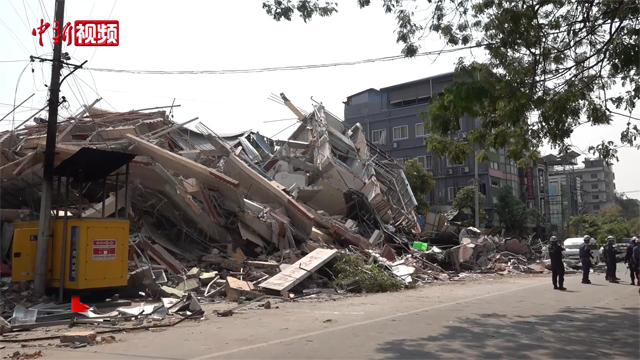11 July 2025—The first studies of the 28 March 2025 magnitude 7.8 Myanmar earthquake suggest that the southern portion of its rupture occurred at supershear velocity, reaching speeds of 5 to 6 kilometers per second.
In their paper published in The Seismic Record, seismologists Lingling Ye, Thorne Lay and Hiroo Kanamori share new details about the devastating earthquake, which caused widespread and severe damage in Myanmar and neighboring countries such as Thailand, with more than 5,000 confirmed casualties. The earthquake ruptured about 480 kilometers of the Sagaing Fault that extends north-south through the central part of the country.
The researchers analyzed seismic and satellite imagery to conclude that the rupture had large slip of up to seven meters that extended about 85 kilometers north of the earthquake’s epicenter near the city of Mandalay. Slip along the 395 kilometers of rupture to the south of the epicenter was more patchy, from 1 to 6 meters and about 2 to 3 meters near the country’s capital of Nay Pyi Taw.
Initial reports suggested that some parts of the rupture might have reached supershear—faster than the speed of shear waves—velocity, which the authors confirmed in this study.
Measurements of strong ground motion recorded by a seismic station near Nay Pyi Taw roughly 5 kilometers km west of the Sagaing fault were “immediately convincing of supershear rupture given the time between the weak, dilational P wave first arrival and the arrival of large shear offset of the fault” at the station, said Lay. “That was unusually clear and convincing evidence for supershear rupture relative to other long strike-slip events that I have worked on.”
“This is one of the closest seismic stations to record the rupture passage for a great earthquake. Earthquake seismologists have long desired to have near-fault records like this.” Ye added.
The weak initial P waves hit the station about 36 seconds after the earthquake began, with much stronger motions starting just 12 seconds after that.

The strong directivity of the rupture toward the south, combined with the supershear velocity, may have been responsible for the damaging impacts felt as far away as Bangkok, the researchers suggested.
There have been several large earthquakes of magnitude 7 or larger in the 20th century along the Sagaing Fault, particularly along the northern portion of the fault. But the 28 March earthquake ruptured a part of the fault between Mandalay and Nay Pyi Taw that had been seismically quiet since 1912 and 1839.
The characteristics of the preceding “seismic gap” are still unclear, said Lay.
“The 2025 event appears to have ruptured a bit further north and further south than might be expected from the locations of prior events in 1956 in the north and 1930 in the south, but the precise locations and slip distributions for those events are not known,” he explained. “The overlap in the north and south with the ruptures in 1956 and 1930 may represent our lack of knowledge of precise strain release patterns for those two events, or incomplete strain release in those earlier events.”
“Longer histories and better understanding of fault segmentation and geometry are needed to have any guidance for future event activity, but I would not expect the central area to fail again before a long period of rebuilding strain energy,” he added.
The 2025 rupture is exceptionally long for a strike-slip rupture of this magnitude, the researchers noted. It is comparable to the roughly 400 kilometers-long 1906 San Francisco rupture, but longer than the 2023 East Anatolian Fault earthquake in Türkiye and the 2002 Denali earthquake in Alaska.
“The length of the rupture is on the high end relative to the seismic moment, but I suspect that relative straightness of the fault in the southern two-thirds of the rupture helped enable rupture along the southern end, combined with the long time since prior large rupture of the central portion of the fault,” said Lay.
[Read more about the Myanmar earthquake and how CCTV video captured its curved fault slip for the first time in this paper from The Seismic Record.]
